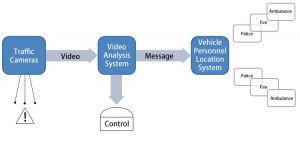
Public safety enhanced by “seeing through the crowd”
For as long as people have lived in cities, criminals and terrorists have escaped capture by hiding in crowds. Video surveillance in the form of CCTV made its debut decades ago and does provide some deterrence, even if simply by the visible presence of video cameras. In fact, eBay offers plenty of fake cameras for sale just for this purpose.
But passive CCTV systems have their limits. They are only useful for forensic analysis after an event and such investigations can take a lot of time and intense concentration to pursue.
Fast forward to today’s video analytics
Cities around the world are installing systems that combine advanced multi-sensor analytics (video, sound and smell analytics using all the senses that humans do) with vehicle and people recognition systems, GPS mapping capabilities and wireless communications.
The aim is to automate surveillance and provide faster, more effective responses. Public safety officials can now increase the protection of people and property, plus accelerate emergency response using systems like iOmniscient’s Automated Surveillance Action Platform (ASAP).
In an ASAP system, the core capability is based on powerful analytics. If the system generates numerous false alarms, it would play havoc in an automated system. But iOmniscient’s analytics systems are all are armed with NAMS—a Nuisance Alarm Minimization System.
Reduced false alarms
This helps reduce false alarms by two orders of magnitude compared to systems that do not have this capability. Based on this, the system determines the type of first responder needed. If the event detected was a fire, ASAP would alert the fire brigade. If the incident was a road accident, ASAP would call the police and so on.
Next it would find the nearest First Responder to the camera based on the GPS co-ordinates of their vehicle or smart phone. It would provide them with information on the event instructions on how to get there.
The information can also be sent to a central control room, where the operators have the ability to take control of a situation, if they think they need to intervene. However, for a large proportion of public safety incidents, the actions can be taken automatically by the ASAP system. This leaves the operators more time to handle other and more complex situations
More effective responses
The ASAP system not only helps authorities respond more quickly, but also more effectively because they have knowledge of the situation before getting there. In cities where ASAP has been deployed, it has reduced the response time from an average of 25 minutes to less than 5 minutes.

Figure 1. Overview of how iOmniscient ASAP video analytics system works.
iOmniscient’s ASAP system uses a range of Microsoft platforms, including Windows Server 2008, SQL Server 2007 R2 and 2014, Visual Studio 2015, the Windows .NET framework, the Microsoft Kinect SDK, and Windows 8.1 (soon to be upgraded to Windows 10). It can be deployed as an on-premises solution or hosted via the Microsoft Azure cloud to save cities capital expenses and provide easier maintenance and automatic upgrades.
Cities around the world are deploying iOmniscient’s advanced technologies as part of their public safety infrastructure. It can be easily and quickly incorporated into existing municipal and police video systems. The Royal Thai Police in Bangkok have started implementing iOmniscient’s technologies following the August bombing that killed 20 people and injured 125. They expect their new system will improve policing and help reduce incident response times by an order of magnitude.
See a 2:05 video of how ASAP advanced analytics can provide facial recognition and automated responses to enhance public safety. For more information, visit www.iomniscient.com.
iOmniscient is a Microsoft CityNext partner who showed their public safety solutions at Smart City Expo World Congress in Barcelona. Follow iOmniscient for updates and follow Microsoft CityNext on Twitter for news, trends, and smart city solutions.
Have a comment or opinion on this post or a question for the author? Please let us know on Twitter or LinkedIn.




